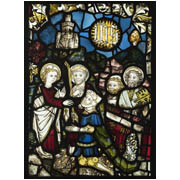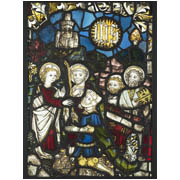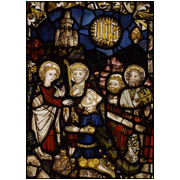Details
- Object type
stained glass panel
- Title
St John the Evangelist Hands the Palm to the Jewish Chief Priest
- Place Associated
England, Norfolk, Norwich (place of manufacture); Church of St Peter Mancroft, Toppes Window (place of use)
- Date
1450-1455
- Materials
white, coloured, pot metal, silver stain, stained and painted glass, lead
- Dimensions
overall: 679 mm x 483 mm x 10 mm; framed: 698 mm x 504 mm x 10 mm
- Description
-
This rectangular panel depicts a conversion which took place during the funeral procession following the death of the Virgin Mary. A Jewish chief priest, represented here as a soldier wearing a blue surcoat ornamented with three green leopards' faces, over plate armour, kneels at the centre of the scene. He holds a palm branch, which has given him by St. John (standing clothed in a white mantle over a red tunic on the left). The Virgin's coffin covered with a red drape bearing the initial 'M' can be seen on the right; St. Peter with a large yellow key, and two other apostles can be seen behind.
The Golden Legend, not the Bible, retells the story of the Death, Funeral and Assumption of the Virgin Mary. It tells how a Jewish chief priest attempted to stop her funeral by turning over the bier. But on touching it his hands withered. The apostles told him that he would be cured if he acknowledged that Jesus Christ is the son of God and that Mary his mother. The Chief Priest subsequently stated this before the amassed crowd. The moment was marked by St John the Evangelist, who handed him a palm frond. This frond had originally been given to the Virgin Mary at the Annunciation, and she had passed it to John. The Chief Priest was to use this symbol to convert his own people. In the Golden Legend, St Peter tells the Priest to take the palm from John, an instruction visible here from Peter’s gesture. An antiquarian description of the window suggests that there was also once a scroll inscribed “ex credo in Jhesum”. The Burrell panel has lost its original background, and has three large medieval insertions.
The window is believed to have come from a window known as the Toppes window, after its donor Robert Toppes, in the church of St Peter Mancroft, Norwich. Toppes was a prominent Norwich citizen, a rich merchant and four times mayor, from the late 1420s until his death in 1467 or 1468. He asked to be buried in the Church’s chapel of St John the Baptist, in front of his window. Of the thirty lights in this window in the East Wall of the North chancel, fifteen lights are still extant.
It has been proposed by David King that the panels telling the story of the Jewish Chief Priest’s attempt to stop the Virgin’s funeral, and his subsequent conversion, may be related to local political events. The leopards’ faces on the surcoat are thought to be a direct reference to William de la Pole, Duke of Suffolk, whose arms were azure a fess between three leopard’s faces two and one or. As King notes, “Disputes between different factions within the city’s governing elite, and between the city and Bishop of Norwich and some local abbots and ultimately with the king, had brought… Toppes and other… citizens associated with Mancroft into direct conflict with de la Pole”. In 1452, two years after de la Pole’s death, Norwich received a new royal charter, confirming the city's liberties of 1447 and pardoning those involved in the disputes of the previous years, this was followed by a royal visit in 1453 by Henry VI and Queen Margaret. It was perhaps under these circumstances the glass was made, proposing that the city’s disputes were not against the king, but specifically de la Pole. Alternatively, the glass may represent some reconciliation with the de la Poles, the family being amongst Queen Margaret’s chief supporters.
Provenance: Ex Coll. Lord Rochdale. Bought by Sir William Burrell via Frank Surgey, 29 October 1948.
Published:
C. Woodforde, The Norwich School of Glass Painting in the 15th Century, 1950, pp. 30-31
William Wells, Stained and Painted Glass, Burrell Collection, 1965, no. 117.
Linda Cannon, Stained Glass in the Burrell Collection, 1991, p. 34, fig. 28, and p. 66, fig. 65
David King, Corpus Vitrearum more
- Credit Line/Donor
Gifted by Sir William and Lady Burrell to the City of Glasgow, 1944
- Collection
Burrell Collection: Stained Glass
- ID Number
45.92
- Location
Burrell Collection



